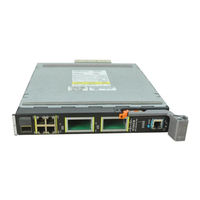Cisco Catalyst Blade 3130 Manuals
Manuals and User Guides for Cisco Catalyst Blade 3130. We have 1 Cisco Catalyst Blade 3130 manual available for free PDF download: Software Configuration Manual
Cisco Catalyst Blade 3130 Software Configuration Manual (1380 pages)
Software Guide
Table of Contents
-
-
Features51
-
-
-
-
-
NTP Version 4128
-
-
-
-
-
-
-
-
Device Roles251
-
Host Mode260
-
MAC Move262
-
MAC Replace262
-
Accounting263
-
Readiness Check264
-
Guidelines280
-
-
-
-
-
-
-
Device Roles316
-
Host Detection316
-
Session Creation317
-
-
Guidelines320
-
-
-
Port Security321
-
Gateway IP322
-
Acls322
-
X Authentication322
-
-
Etherchannel322
-
-
-
-
Port-Based Vlans334
-
Switch Ports334
-
Access Ports335
-
Trunk Ports335
-
Tunnel Ports335
-
-
Routed Ports336
-
-
-
-
-
Supported Vlans372
-
-
-
Token Ring Vlans376
-
Displaying Vlans384
-
-
Configuring VMPS396
-
-
The VTP Domain404
-
VTP Modes405
-
VTP Version 2406
-
VTP Version 3407
-
VTP Pruning408
-
Configuring VTP410
-
-
Domain Names411
-
Passwords412
-
VTP Version412
-
-
Monitoring VTP420
-
-
-
-
-
-
STP Overview464
-
-
Blocking State468
-
Listening State469
-
Learning State469
-
Forwarding State469
-
Disabled State469
-
-
-
-
-
-
Hop Count491
-
Boundary Ports492
-
-
-
-
-
-
-
Flex Links536
-
-
-
-
DHCP Server550
-
DHCP Relay Agent550
-
-
DHCP Snooping550
-
-
-
-
-
-
IGMP Versions597
-
Immediate Leave600
-
-
Configuring MVR614
-
-
MLD Messages626
-
MLD Queries627
-
MLD Reports628
-
-
-
-
-
Configuring CDP664
-
-
-
-
Local SPAN690
-
Remote SPAN691
-
-
SPAN Sessions692
-
Source Ports694
-
Source Vlans695
-
VLAN Filtering695
-
Destination Port696
-
Rspan Vlan697
-
-
-
Configuring Rmon719
-
-
-
Configuring RMON721
-
-
-
SNMP Versions740
-
Configuring SNMP744
-
SNMP Examples756
-
-
-
-
Supported Acls768
-
Port Acls769
-
Router Acls770
-
VLAN Maps771
-
-
-
-
-
Numbered Acls791
-
Extended Acls791
-
Named Acls792
-
ACL Logging793
-
-
-
-
-
Configuring Qos821
-
-
Basic Qos Model824
-
Classification825
-
Mapping Tables833
-
-
-
-
-
-
-
-
Types of Routing944
-
-
-
-
-
-
-
Configuring RIP962
-
Configuring OSPF967
-
Monitoring OSPF980
-
Configuring BGP989
-
-
-
Configuring Vrfs1025
-
-
-
Enabling PBR1047
-
-
Understanding Ipv61055
-
Ipv6 Addresses1056
-
-
DNS for Ipv61058
-
Icmpv61058
-
Neighbor Discovery1058
-
Ipv6 Applications1059
-
RIP for Ipv61061
-
OSPF for Ipv61061
-
EIGRP for Ipv61061
-
HSRP for Ipv61062
-
-
Limitations1063
-
Configuring Ipv61065
-
Displaying Ipv61082
-
Understanding HSRP1087
-
-
-
HSRP Versions1089
-
Multiple HSRP1090
-
Configuring HSRP1091
-
-
Enabling HSRP1093
-
-
Configuring MHSRP1096
-
Configuring VRRP1099
-
VRRP Limitations1099
-
-
-
-
-
-
Understanding WCCP1126
-
WCCP Negotiation1127
-
MD5 Security1128
-
Configuring WCCP1129
-
-
-
Understanding IGMP1139
-
IGMP Version 11139
-
IGMP Version 21139
-
-
Understanding PIM1140
-
PIM Versions1140
-
PIM Modes1140
-
PIM Stub Routing1141
-
IGMP Helper1142
-
Auto-RP1143
-
Bootstrap Router1143
-
-
Understanding DVMRP1145
-
Understanding CGMP1145
-
-
-
-
SSM IP Address Range1152
-
SSM Operations1152
-
Configuring SSM1154
-
Monitoring SSM1154
-
-
SSM Mapping Overview1155
-
-
SSM IP Address Range1160
-
SSM Operations1160
-
Monitoring SSM1162
-
Configuring SSM1162
-
-
-
-
Understanding MSDP1205
-
-
-
MSDP Operation1206
-
MSDP Benefits1207
-
Configuring MSDP1208
-
-
-
-
Troubleshooting1237
-
-
-
Using Ping1246
-
Understanding Ping1247
-
Executing Ping1247
-
-
Using IP Traceroute1249
-
Using TDR1251
-
Using Debug Commands1252
-
-
Understanding OBFL1259
-
Configuring OBFL1259
-
-
-
-
-
Copying Files1273
-
Deleting Files1274
-
-
-
-
-
Access Control Lists1311
-
Archive Commands1312
-
ARP Commands1312
-
Boot Loader Commands1312
-
Debug Commands1313
-
Fallback Bridging1314
-
Hsrp1315
-
Interface Commands1316
-
IP Multicast Routing1317
-
IP Unicast Routing1319
-
MAC Address Commands1321
-
Miscellaneous1321
-
Msdp1322
-
Netflow Commands1322
-
Snmp1324
-
Spanning Tree1324
-
Vlan1324
-
Advertisement
